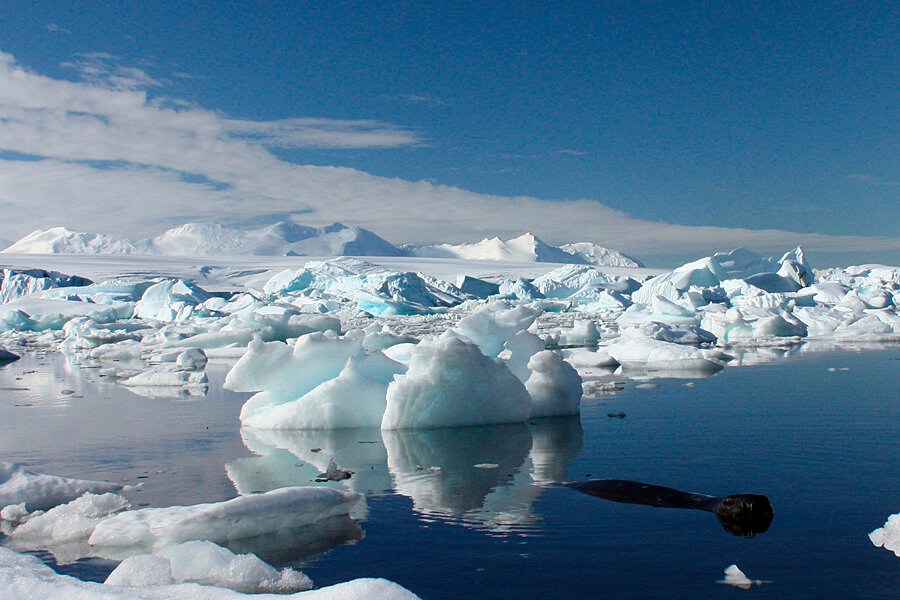Antarctic fur seals, once hunted to near extinction, now face climate threat
Loading...
Climate change appears to be pulling the ecological rug out from under a once-stable population of Antarctic fur seals. Their numbers on a remote island in the South Atlantic are falling, even though an increasing proportion of survivors are displaying greater genetic variation – a trait generally thought to boost an organism's ability to adapt to environmental stress.
That's the pattern a pair of scientists has detected in a new study of the seal population, which researchers have been scrutinizing for 31 years at the level of individual seals as well as at the wider population level.
The work has implications beyond the seals themselves, the researchers say.
The seals, which feed on Antarctic krill, sit near the top of the food chain, notes Joe Hoffman, a molecular ecologist at Bielefeld University in Bielefeld, Germany, and one of the two scientists reporting the results in Thursday's issue of the journal Nature.
As a result, the seals tend to reflect the general health of the ecosystem they inhabit and so are "an indicator for many other species," he explains.
Until the 1990s, the seals inhabiting the South Georgia and South Sandwich Islands, some 1,100 miles east of the southern tip of South America, represented a good-news conservation story. The seals there were nearly hunted to extinction during the 19th century. By the 1990s, the number of seals had rebounded to a population estimated at about 3 million and considered stable. In the colony the two researchers studied, however, the number of breeding females fell by by 25 percent over the past 27 years.
"The motive for this study was to find out what was causing the decline and if the cause of the decline was a problem for the entire ecosystem as a whole," Dr. Hoffman says.
Hoffman and Jaume Forcada, a biologist with the British Antarctic Survey and the study's lead author, focused on females, because they reach reproductive maturity and come ashore to breed when they are three-to-four years old. Over 30 years, data accumulated on many generations of offspring. Males, on the other hand, don't start coming ashore until they are about 10 years old and are big enough to tangle with already established males in the breeding colony.
In addition to the general decline in breeding females during the past 27 years, female pups on average weighed 7.8 percent less at birth than they did in the '90s. The average time span covered by a generation shrank from 13.7 to 6.1 years. And the number of females whose genetic makeup displayed the least variety fell by 17 percent, boosting the proportion of females with high genetic variation. Yet this high genetic variation, which increases the likelihood that an individual will survive the tougher environmental conditions, can't be passed from mother to pups, the researchers note.
Females that reached reproductive age and returned to the island to breed tended to be among the larger, older females and generally bore their first pups a year later than they did in the '90s, the researchers found.
These patterns tend to be associated with animals facing food shortages. In exploring the factors determining the abundance and distribution of krill, climate patterns are crucial, the team notes. In particular, they point to a band of high-altitude winds encircling Antarctica. The band expands and contracts on average in a cycle known as the Southern Annular Mode.
Between 2003 and 2012, the mode entered a phase in which the band of high-altitude winds generally contracted toward the South Pole, allowing warmer water to migrate farther south into regions where the seals gulp krill. When the water warms, krill populations fall.
Overall, the breeding population of females dropped by 30 percent during this period.
This phase has been attributed to a combination of the ozone hole over Antarctica and global warming, and models project an increase in the persistence of the phase with additional warming.
Hoffman notes that within about five years, it should be possible to begin exploring genetic variability among male seals.
"We might expect even more extreme effects simply because the male mating system is much more competitive," he says.
What sets this study apart from others that have tried to look at the effects of climate change on populations of animals is the long records on individual seals, their sizes, weights, and genetic information.
Armed with these data, "we can obtain very clear evidence that as the climate is changed, it's getting more difficult for these animals to get by," he says, because conditions are changing faster than the animals can evolve to adapt to the changes.
Given fur seals' bellwether status and the range of other species that rely on the same source of food, Hoffman says it's possible that other species in the Southern Ocean may be experiencing similar changes.
He and Dr. Forcada speculate, however, that as environmental conditions get worse, natural selection could lead the genetic diversity within individuals to become dominant enough to persist in the population, better equipping it to adapt to future changes.






